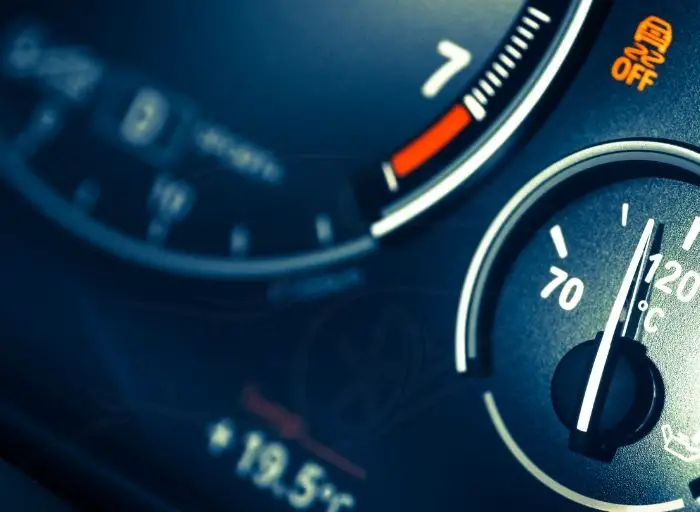
Engines can run between 180 and 240 degrees Fahrenheit. That’s a huge difference. But, remember this: Any hotter and the engine will degrade and possibly even catch on fire. Any cooler and you’ll lose power. So, how do you make sure your engine is always at the right temperature? If this is what you’re concerned about, this complete guide about normal coolant temperature is right for you.
Table of Contents
Why Should You Care About The Engine Temperature?
You should be very concerned because an overheated engine can be very expensive, not only in the form of repair costs but also in the loss of engine performance and even the potential for damage to other parts of your car or truck. When you first start driving, it’s important to drive slowly and pay attention to what the car is telling you. If the temperature warning light comes on, don’t drive faster; take the car to a repair shop immediately. This will prevent irreversible damage to the engine.
Engine Temperature Gauge 101
Cars built since 1996 are required to have a “trip computer” which monitors many different conditions inside the vehicle, including coolant temperature. This allows the driver to get an early warning if something is wrong with the vehicle’s cooling system.
In most cars, the temperature needle will be at or near the center when the engine is at normal operating temperature. Usually, it takes a few minutes for the engine to get to operating temperature after starting a cold engine.
Some vehicles have gauges that are so sensitive they need a battery of tests to ensure the needle reaches the “midpoint”. Don’t be alarmed if the needle stops short of the midpoint. It might take several test drives until you get one that has the sensitivity you require.
When you first start driving a car, you should pay close attention to where your engine is when it is first warmed up. That way, if anything seems “off” you’ll have a benchmark to compare it to, and thus know whether or not your car is acting up. That way, if the needle starts creeping up higher, closer to the hot mark, you’ll have early notice that something is wrong in the cooling system.
Normal Engine Coolant Temperature
Whether your car is new or old, the temperature of the engine coolant should be somewhere in the mid-160’s (Fahrenheit). It should never drop below 160 degrees even when the engine is hot. A much better question you should be asking is what temperature is your engine really running at?
If it’s too high, then you need to be concerned about engine damage. Too low, and your engine will never run efficiently which will cost you money. You should have your car inspected by a professional every year, just as you would have your engine checked.
Many cars being sold today have an engine temperature warning system. It usually consists of a small dial on the instrument panel which displays the engine temperature. When the engine gets too hot, a little red or orange icon with a thermometer on it will appear on the dial. There’s also usually a little yellow arrow pointing down at the icon which means the engine is getting too hot.
Normal Coolant Temperature in Celsius
The ideal temperature for your body to function at its peak is also an important consideration. Your optimal body temperature is about 98.6 degrees. This ranges from about 194 degrees Fahrenheit to about 218 degrees Fahrenheit. The thermostat keeps the engine from overheating by regulating the amount of coolant that flows through the radiator. It does this by letting more or less “hot” coolant out of the system.
You need to pay close attention to the weather in your area. Anything over 100*F (38*C) is too hot, so make sure you aren’t exposing yourself to that type of weather.
Out Of Ranges Consequences
If the gasoline gets too hot, it will “detonate” or burn before the engine has a chance to get hot. This will result in reduced horsepower and often causes engine damage. This can cause a knock or ping in the engine. It’s an unnecessary expense. Just add a little more oil. It costs much less to have the mechanic check the oil than it does to replace the engine.
Running an engine without an oil change can cause excessive wear and tear on the engine’s moving parts. This in turn can lead to:
- Increased maintenance costs
- Reduced horsepower
It can also result in a blown engine head gasket. It doesn’t matter how much you push or how many tricks you know if the battery is dead.
There are several possible causes for an engine to overheat. First, there could be a problem with the fan belt or other belts connecting the engine to the rest of the car.
Final Words
A coolant temperature is the maximum temperature of the coolant that the engine can handle without damage. Most car engines are designed to run with a coolant temperature of 120 degrees Fahrenheit. The engine coolant is getting too hot if it’s around 240 degrees or higher. Paying attention to your engine temperature will help you prevent possible issues with the car.
Hi there! I’m Naomi O’Colman. I’ve got years of experience working at an auto repair shop here in Texas under my belt. On top of that, ever since I was a kid I’ve been passionate about the auto industry. Since I’ve joined the team at automotivegearz.com I’ve been enthusiastically sharing my passion and insights with my readers. I’m dedicated to delivering high quality content and helping you stay up to date with the latest automotive trends and products out there!







